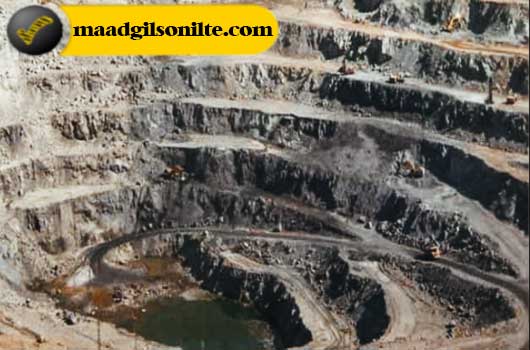
The problem of water is one of the big challenges that bitumen miners face, it is the infiltration of water into these mines that can cause various problems. In this article, we will explore solutions to prevent water from entering natural bitumen mines and ensure the efficient extraction and use of this essential resource.
1- Understand the water problem
To find effective solutions, it is important to understand why water intrusion occurs in bitumen mines. Water can seep into mines through cracks in the ground or due to insufficient sealing, leading to increased moisture levels. This not only affects the quality of the bitumen, but also poses risks to the miners’ safety.
2- Proper evaluation of the mining site
One solution is to conduct full mine site assessments before the mining process begins. Geological surveys can help identify potential water sources nearby. By avoiding locations that are prone to flooding or near water, miners can minimize the risk of water intrusion.
3- Implementation of effective drainage systems
Installing efficient drainage systems inside mines can significantly reduce water ingress. These systems can include pumps, channels, and pipelines that collect and transport water from the active mining area. Regular maintenance and inspection of these systems is essential to ensure their effectiveness.
4- Creating effective barriers to prevent water problems
Building strong barriers around the mining area is critical to prevent water from entering the pits. Reinforced concrete walls or embankments can be built around the excavation site to provide a physical barrier to prevent water infiltration.
5- Using waterproof membranes
Waterproof membranes, usually made of synthetic materials such as geomembranes, can be used as linings for mine cavities. These membranes act as a waterproof barrier and prevent water from penetrating the mine walls and bitumen contamination.
6- Regular monitoring and maintenance
Continuous monitoring of the mine water level is very important to identify any potential infiltration points. Regular inspections and maintenance should be performed to identify and repair cracks, crevices or other openings through which water may enter the mining area.
– Use of injection techniques
Injection techniques involve injecting cementitious or chemical materials into the ground to fill voids or stabilize the soil. Using these techniques around the mining area can help reduce water leakage by sealing off potential pathways for infiltration.
7- Using advanced technology
Technological advances can help prevent water intrusion into bitumen mines. For example, ground-penetrating radar systems can be used to identify potential sources of groundwater and enable better mine planning and management.
8- Cooperation and knowledge sharing about the water problem
Collaboration between mining companies, environmental agencies and research institutions can promote knowledge sharing and best practices to minimize water intrusion. This collective effort can lead to the development and adoption of more effective and sustainable solutions.
9- Monitoring the environment
Finally, maintaining a strong commitment to environmental stewardship is essential in preventing water intrusion. By implementing responsible mining practices, such as reclaiming and restoring disturbed areas, miners can minimize their impact on the surrounding ecosystem and reduce the potential for water pollution.
In the extraction of natural bitumen open pit mines, bitumen, with the minimum price and optimal quality, is the most important goal of mining. The natural bitumen mines in the west of the country are not excluded from the presence of water, like other open pit mines in the world. For this reason, the evaluation of the mining operation in the open pit mines of Gilan Gharb is of special importance due to the extensiveness of this process, which results in the production of raw materials with good quality and favorable price. , increase.
Also, the existence of water problem increases the costs of drilling and blasting and makes the use of waterproof explosives necessary. The water pressure behind the mine walls causes the instability of these walls, and on the other hand, the wet conditions of the mine lead to premature wear and tear of the equipment. Contact with water, either due to rain or underground water, is a natural result of the deepening of a mine. And the consequence of the collision with the underground water level is water entering the mine, which is a nuisance at best and a danger at worst.
The problems caused by water problems in mining operations increase the cost of bitumen extraction, reduce the efficiency of machinery and manpower, increase the statistics of accidents, electrical problems, etc. Therefore, the deep drainage of underground water can be an effective help in reducing the mentioned problems and major savings in the overall costs of natural bitumen extraction. Water drainage can be an effective help in reducing the mentioned problems and major savings in the overall costs of extraction.
Today, one of the problems of open-pit natural bitumen mines in the west of the country is the entry of underground water into the mineral pit, which poses problems to all mining activities and drainage management. Drainage galleries are one of the solutions to control the level of underground water. In the mining process, if the underground water drainage system is stopped, there is a possibility that the water will return to the original level.
Most of the open pit natural bitumen mines of Gilan Gharb, in some places during the lifetime of the mine, must encounter some water, which is generally harmful for the operational activities of the mine. These operational effects can have significant financial consequences for an open pit mine.
Wet mining has the following negative operational effects:
1- The collapse of some pits, which need to be dug again due to the presence of water, will play a significant role in increasing the finished product price compared to dry conditions.
2- Transportation of mineral matter and wet waste
3- Low efficiency of loading and unloading
4- Temporary loss of access to some parts of the pit of the natural bitumen mine, as a result of reducing the safety and stability of the slope of the mine walls and stairs
Also, in wet mining conditions, due to the high humidity of water, the duration of mine tailings removal increases.
It is better to calculate the production cost of each ton of extracted natural bitumen by determining the underground water model and the type of drainage. To reduce all mining costs and spend that cost on development projects in the mine.
By draining underground water in bitumen open pit mines, favorable mining operations will be provided at a lower cost along with sustainable development. Preventing water infiltration in bitumen mines requires a multifaceted approach that includes appropriate site assessments, effective drainage systems, barriers Strong, waterproof membranes, regular monitoring, injection techniques, advanced technology, collaboration and environmental monitoring. By applying these solutions and continuous efforts to improve, we can guarantee the extraction and sustainable use of natural bitumen while protecting the environment and the safety of miners.

